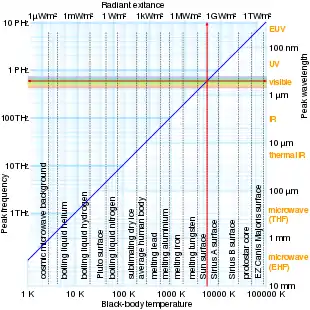Stefan–Boltzmann constant
The Stefan–Boltzmann constant (also Stefan's constant), a physical constant denoted by the Greek letter σ (sigma), is the constant of proportionality in the Stefan–Boltzmann law: "the total intensity radiated over all wavelengths increases as the temperature increases", of a black body which is proportional to the fourth power of the thermodynamic temperature.[1] The theory of thermal radiation lays down the theory of quantum mechanics, by using physics to relate to molecular, atomic and sub-atomic levels. Slovenian physicist Josef Stefan formulated the constant in 1879, and it was later derived in 1884 by Austrian physicist Ludwig Boltzmann.[2] The equation can also be derived from Planck's law, by integrating over all wavelengths at a given temperature, which will represent a small flat black body box.[3] "The amount of thermal radiation emitted increases rapidly and the principal frequency of the radiation becomes higher with increasing temperatures".[4] The Stefan–Boltzmann constant can be used to measure the amount of heat that is emitted by a blackbody, which absorbs all of the radiant energy that hits it, and will emit all the radiant energy. Furthermore, the Stefan–Boltzmann constant allows for temperature (K) to be converted to units for intensity (W⋅m−2), which is power per unit area.

Since the 2019 redefinition of the SI base units, the Stefan–Boltzmann constant is given exactly rather than measured in experiment. The value is given in SI units by
- σ = 5.670374419...×10−8 W⋅m−2⋅K−4.[5]
In cgs units the Stefan–Boltzmann constant is:
- σ ≈ 5.67037441918442945397×10−5 erg⋅cm−2⋅s−1⋅K−4.
In thermochemistry the Stefan–Boltzmann constant is often expressed in cal⋅cm−2⋅day−1⋅K−4:
- σ ≈ 11.7×10−8 cal cm−2⋅day−1⋅K−4.
In US customary units the Stefan–Boltzmann constant is:[6]
- σ ≈ 1.714×10−9 BTU⋅hr−1⋅ft−2⋅°R−4.
The value of the Stefan–Boltzmann constant is derivable as well as experimentally determinable; see Stefan–Boltzmann law for details. It can be defined in terms of the Boltzmann constant as
where:
- kB is the Boltzmann constant
- h is the Planck constant
- ħ is the reduced Planck constant
- c is the speed of light in vacuum.
The CODATA recommended value [ref?] prior to 20 May 2019 (2018 CODATA) was calculated from the measured value of the gas constant:
where:
- R is the universal gas constant
- NA is the Avogadro constant
- R∞ is the Rydberg constant
- Ar(e) is the "relative atomic mass" of the electron
- Mu is the molar mass constant (1 g/mol by definition)
- α is the fine-structure constant.
Dimensional formula: M1T−3Θ−4
A related constant is the radiation constant (or radiation density constant) a which is given by:[7]
References
- Krane, Kenneth (2012). Modern Physics. John Wiley & Sons. p. 81.
- "Stefan-Boltzmann Law". Encyclopædia Britannica.
- Halliday & Resnick (2014). Fundamentals of Physics (10th Ed). John Wiley and Sons. p. 1166.
- Eisberg, Resnick, Robert, Robert (1985). Quantum Physics of Atoms, Molecules, Solids, Nuclei, and Particles (2nd Ed) (PDF). John Wiley & Sons. Archived from the original (PDF) on 2014-02-26.
- "2018 CODATA Value: Stefan–Boltzmann constant". The NIST Reference on Constants, Units, and Uncertainty. NIST. 20 May 2019. Retrieved 2019-05-20.
- Heat and Mass Transfer: a Practical Approach, 3rd Ed. Yunus A. Çengel, McGraw Hill, 2007
- Radiation constant from ScienceWorld
External links
 Media related to Stefan–Boltzmann constant at Wikimedia Commons
Media related to Stefan–Boltzmann constant at Wikimedia Commons